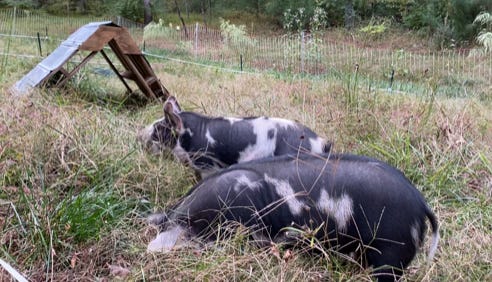Surprises from our first 2 months with pigs
We brought home our first two Idaho Pasture Pigs in August. Here’s what we didn’t expect.
In an earlier post I shared about our first 24 hours with pigs. We moved them on one of the hottest weekends of the summer, and now I’m tossing straw into their shelter as we hover just above freezing some nights. I watch Fred and Barney not only enjoy the cooler weather when they nap in the sun, but they’re rotating to spaces where hickory nuts have fallen, and they’re moving closer to the chicken coop, so some of the girls have wandered into their paddock to hang out with them.
Easier than chickens. In that earlier post I had shared what many folks with pigs told me: Pigs are easier than chickens. To me, that still remains true. Some days I completely forget they’re here until it’s their dinner time. They’re remarkably quiet unless they’re hungry (or they get an electric fence reminder).
We still have compost. Several people have asked me if we’re missing out on compost from feeding all food scraps to the pigs. My answer is no. We generally have minimal food scraps since the chickens help out with them. From what others have told me, pigs don’t care for peppers and tomatoes, and those make up a lot of our food scraps as the main growing season slows. Instead, the chickens get those. Most of our compostable items are egg shells, coffee grounds, and cardboard. Although the pigs got whole eggs almost daily when the chickens were laying more abundantly, I wouldn’t add egg shells as a long-term daily dose. For the pigs, I funnel herb stems, apple skins, many veggie trimmings (beans, potatoes, kale stems, etc.).
They take a long time to eat. On the topic of the pigs’ diet, we’ve been surprised how long it takes for them to eat their dinners. I thought that “eating like a pig” meant that they would eat everything in a few bites. Instead, it takes them almost an hour to eat their meals. When we first brought them home, they were consuming a little over 1 lb per day and were about 20 lbs each. Now they’re consuming 2 lbs per day and they’re maybe 75 lbs each. They’re gaining between 1-to-2 lbs per day.
A fence is good until it’s not. A few weeks ago, we went out of town to celebrate our wedding anniversary. It was a cloudy weekend and we had moved the solar electric fence charging station to a new spot before we left. When we got home, I noticed that the pigs were roaming and rooting very close to the electric fence along with the pigs as they rotated. Every time I’d stop by to pet and check on the pigs, they leaned into my hand and pushed toward the electric fence without a care. When I checked the charging station, I realized I wasn’t hearing the metronome-like click of the power that runs the system. We recharged the battery immediately and the fence was fine--until it wasn’t. I’ve been checking the charger almost daily and the performance remained consistent until last week. We had another drop in battery power and re-charged again. The root cause, from what we’re observing, is the charger location. The solar panel and the spot where we had placed it had dappled light rather than full sun. Now we have their charger in full sun and the charger’s display shows strong and steady.
We got the “day” we wanted for them next year. Processors are in high demand as both food demand rises, more people raise their own livestock, and (humane) processing facilities become harder to find in North Carolina. Back in 2020 during the shutdown, processors were so backed up and delayed, that millions of animals were euthanized in North Carolina alone. Earlier this month another North Carolina pork processor announced a closure, plus closures of almost 3 dozen of their hog farms out of state. I find it interesting that the article cites a reduced demand and low prices. With a growing number of people raising their own meat, others choosing to source their meat from ethical sources, and vegan and plant-based trends, perhaps the CAFO (concentrated animal feeding operations) that keystone our broken food system are finally feeling the cultural change. We hoped to get a processing date in late February through late March—early April at the latest. We got one the last week of February at an Animal Welfare Approved, USDA processing facility just about an hour from home.
Knowing that “day” is ahead, we’re now exactly a third of the way through our first experience raising pigs. It’s not a surprise to me, but our time with them so far affirmed my decision that two is a good fit for us. Not only with how much that will provide for our family for the next few years, but also their individualized care. Feeding and moving them, belly rubs and attention—carrying two feed bowls and rubbing two bellies is feasible for me. I have a hard time imagining how I would manage more. Several people have asked me if we’re interested in raising them and getting a breeding pair. I wasn’t interested in that before we got them, and I’m still not. For our particular household needs and hobby farm interests, having pigs full-time wouldn’t fit. I love that this experience has a clear end date and it makes me appreciate this time, and our future meals, even more.






